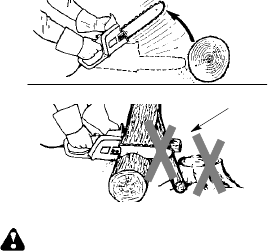
4
GUARD AGAINST KICKBACK
Follo w all safe ty r ules to he lp avoid kick-
back and other forces which can r esult i n
serious i njur y.
Kickback Path
A
v
oid Obstructions
Clear The WorkingArea
WARNING: Avoid kickback which
can resultin serious injury. Kickbackis
the backward, upward or sudden for-
ward motion of the guide bar occurring
whenthesawchainneartheuppertip of
the guide bar contacts any object such
as a log or branch, or when the wood
closes in and pinches the saw chain in
the cut. Contacting a foreign object in
thew ood can also resultin loss of chain
saw control.
S Rotationa l Ki c kbac k can occur when
the moving chain contacts an object at
the upper t i p of the gui de bar. This con-
tactcancausethechaintodigintothe
object, which stops t he chain for an
inst ant. The result is a light ning fast, r e-
versereact ionwhichkicksthe g uidebar
up and back toward t he oper ator.
S Pinch-Ki ckback can occur when the
the wood closes in and pinches the
movi n g saw chain in t he cut alo ng the
topoftheguidebarand thesawchainis
suddenly stopped. This sudden stop-
ping of t he chain r esults in a reversal of
the chain force used to cut wood and
causes the saw to move in theoppos i t e
dir ecti on of the chain rotati on. The saw
is d r i venstraightback t owar dthe oper a-
tor.
S Pull-I n can occur when the moving
chain contacts a foreign obj ect in the
wood i n the cut along the bottom of the
guidebarand t hesawchainis s uddenly
stopped.This sudden st oppi ng pullsthe
saw for war d and away f r om the opera-
tor and could easil y cause the operator
to lose cont rol of th e sa w.
REDUCE THE CHANCE OF
KICKBACK
The foll owi ng pr ecauti ons should be f ol-
lowe d to minim ize kickback:
S Recognize that kickback can happen.
Wit h abasic understandi ng ofkickback,
you can reduce the elem e nt of surpr ise
which contr ibut es t o accident s.
S Never let the moving chai n contact any
object at the ti p of the guide bar.
S Keep working area free from obstruc-
tions such as other t r ees, branches,
rocks, f e nces, st u mp s, et c. Elimi nate or
avoid any obstru ctio n that your saw
chain could hit while cutt i ng.
S When cut t ing a branch, do not let the
guidebarcontactanot herbranchoroth-
er objects around it .
S Keep saw chain sharp and properl y
tensioned. A loose or dull chain can i n-
crease the chance of k i ckba ck. Follow
manufacturer’s chain sharpeni ng and
mai ntenance inst ruct i on s. Check ten-
sion at regular interval s, but never with
engi ne r unn ing. Make sure bar clamp
nuts are securel y t i ghtened.
S Begin andco nt i nue c utt i ngat ful lspeed .
Ifthe chainis movingata slowerspeed,
there i s gr eat er chance of ki ckback oc-
curri ng.
S Use extr em e c aut i on when re-ent er i ng
acut.
S Do not at tempt cuts start i ng wi t h t he tip
of t he bar (plunge cuts).
S Wat ch for shifti ng logs or other objects
that could close a cut and pinch or f al l
onto chain.
S Use the specified R educed-Kickback
Guide Bar and Low Kickback Chain.
Avoid Pi nch-Ki c kback:
S Be extr emel y aware of sit uat i ons or ob-
str u ction s that can cause m a t e rial to
pinch t he to p of or other w ise stop the
chain.
S Do not cut more than one log at a ti m e.
S
Do not twist the saw as the bar is wi th-
drawn from an undercut when bucking.
A voi d Pull- I n :
S Always begin cutti ng wit h t he saw at full
speed and the saw housi ng agains t
wood.
S Use wedges made of p l asti c or wood.
Never use metal to hold t h e cut open.
MAINTAIN CONTROL
S A good, firm grip on the saw wit h both
hands will help you mai ntai n contr ol .
Don’ t let go. Gr ip the rear h a nd le with
your ri ght hand whet her you are right or
lefthanded. Wrapthefi ng ersofyourlef t
hand over and around the front handle-
bar, and your l ef t thumb under the f r ont
handlebar. Keep your l ef t arm straight
with the elbo w locked.


















